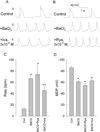Differential effects of ivabradine and ryanodine on pacemaker activity in canine sinus node and purkinje fibers
- PMID: 22353259
- PMCID: PMC3360135
- DOI: 10.1111/j.1540-8167.2011.02285.x
Differential effects of ivabradine and ryanodine on pacemaker activity in canine sinus node and purkinje fibers
Abstract
Introduction: It is generally accepted that at least 2 major mechanisms contribute to sinus node (SN) pacemaking: a membrane voltage (mainly I(f) ) clock and a calcium (Ca) clock (localized submembrane sarcoplasmic reticulum Ca(2+) release during late diastolic depolarization). The aim of this study was to compare the contributions of each mechanism to pacemaker activity in SN and Purkinje fibers (PFs) exhibiting normal or abnormal automaticity.
Methods and results: Conventional microelectrodes were used to record action potentials in isolated spontaneously beating canine SN and free running PF in control and in the presence of 0.1 μM isoproterenol. Ryanodine (0.1-3 μM) and ivabradine (3 μM) were used to inhibit sarcoplasmic reticulum Ca(2+) release or I(f), respectively. To induce automaticity at low membrane potentials, PFs were superfused with BaCl(2). In SN, ivabradine reduced the rate whereas ryanodine had no effect. Isoproterenol significantly accelerated automatic rate, which was decreased by ivabradine and ryanodine. In normally polarized PFs, ryanodine had no effects on the automatic rate in the absence or presence of isoproterenol, whereas ivabradine inhibited both control and isoproterenol-accelerated automaticity. In PF depolarized with BaCl(2), ivabradine decreased BaCl(2) -induced automatic rate while ryanodine had no effect.
Conclusion: In canine SN, I(f) contributes to both basal automaticity and β-adrenergic-induced rate acceleration while the ryanodine-inhibited Ca clock appears more involved in β-adrenergic regulation of pacemaker rate. In PF, normal automaticity depends mainly on I(f). Inhibition of basal potassium conductance results in high automatic rates at depolarized membrane potentials with SN-like responses to inhibition of membrane and Ca clocks.
© 2012 Wiley Periodicals, Inc.
Figures





Similar articles
-
Carvedilol analog modulates both basal and stimulated sinoatrial node automaticity.Heart Vessels. 2014 May;29(3):396-403. doi: 10.1007/s00380-013-0378-2. Epub 2013 Jul 9. Heart Vessels. 2014. PMID: 23836067 Free PMC article.
-
Beat-to-beat cycle length variability of spontaneously beating guinea pig sinoatrial cells: relative contributions of the membrane and calcium clocks.PLoS One. 2014 Jun 18;9(6):e100242. doi: 10.1371/journal.pone.0100242. eCollection 2014. PLoS One. 2014. PMID: 24940609 Free PMC article.
-
Induction of atrial ectopic beats with calcium release inhibition: Local hierarchy of automaticity in the right atrium.Heart Rhythm. 2010 Jan;7(1):110-6. doi: 10.1016/j.hrthm.2009.09.068. Epub 2009 Oct 7. Heart Rhythm. 2010. PMID: 20129292 Free PMC article.
-
The role of the calcium and the voltage clocks in sinoatrial node dysfunction.Yonsei Med J. 2011 Mar;52(2):211-9. doi: 10.3349/ymj.2011.52.2.211. Yonsei Med J. 2011. PMID: 21319337 Free PMC article. Review.
-
Cardiac pacemaker I(f) current and its inhibition by heart rate-reducing agents.Curr Med Res Opin. 2005 Jul;21(7):1115-22. doi: 10.1185/030079905x50543. Curr Med Res Opin. 2005. PMID: 16004681 Review.
Cited by
-
Cardiac Purkinje fibers and arrhythmias; The GK Moe Award Lecture 2015.Heart Rhythm. 2016 May;13(5):1172-1181. doi: 10.1016/j.hrthm.2016.01.011. Epub 2016 Jan 13. Heart Rhythm. 2016. PMID: 26775142 Free PMC article.
-
The funny current If is essential for the fight-or-flight response in cardiac pacemaker cells.J Gen Physiol. 2022 Dec 5;154(12):e202213193. doi: 10.1085/jgp.202213193. Epub 2022 Oct 28. J Gen Physiol. 2022. PMID: 36305844 Free PMC article.
-
Regulation of heart rate and the pacemaker current by phosphoinositide 3-kinase signaling.J Gen Physiol. 2019 Aug 5;151(8):1051-1058. doi: 10.1085/jgp.201812293. Epub 2019 Jun 19. J Gen Physiol. 2019. PMID: 31217223 Free PMC article.
-
Canine and human sinoatrial node: differences and similarities in the structure, function, molecular profiles, and arrhythmia.J Vet Cardiol. 2019 Apr;22:2-19. doi: 10.1016/j.jvc.2018.10.004. Epub 2018 Dec 14. J Vet Cardiol. 2019. PMID: 30559056 Free PMC article. Review.
-
Chronic heart failure increases negative chronotropic effects of adenosine in canine sinoatrial cells via A1R stimulation and GIRK-mediated IKado.Life Sci. 2020 Jan 1;240:117068. doi: 10.1016/j.lfs.2019.117068. Epub 2019 Nov 18. Life Sci. 2020. PMID: 31751583 Free PMC article.
References
-
- Thollon C, Vilaine J-P. If Inhibition in cardiovascular diseases. Adv Pharmacol. 2010;59:53–92. - PubMed
-
- Fox K, Ford I, Steg PG, Tendera M, Ferrari R. Ivabradine for patients with stable coronary artery disease and left-ventricular systolic dysfunction (BEAUTIFUL): a randomised, double-blind, placebo-controlled trial. Lancet. 2008;372:807–816. - PubMed
-
- Vilaine JP. The discovery of the selective If current inhibitor ivabradine: A new therapeutic approach to ischemic heart disease. Pharmacol Res. 2006;53:424–434. - PubMed
-
- Bohora S, Lokhandwala Y, Parekh P, Vasavda A. Reversal of tachycardiomyopathy due to left atrial tachycardia by ivabradine. J Cardiovasc Electrophysiol. 2011;22:340–342. - PubMed
-
- Sette A, Martino A, Lioy E, Calo L. Efficacy of ivabradine in a case of inappropriate sinus tachycardia and ventricular dysfunction. J Cardiovasc Electrophysiol. 2010;21:815–817. - PubMed
Publication types
MeSH terms
Substances
Grants and funding
LinkOut - more resources
Full Text Sources
Miscellaneous

